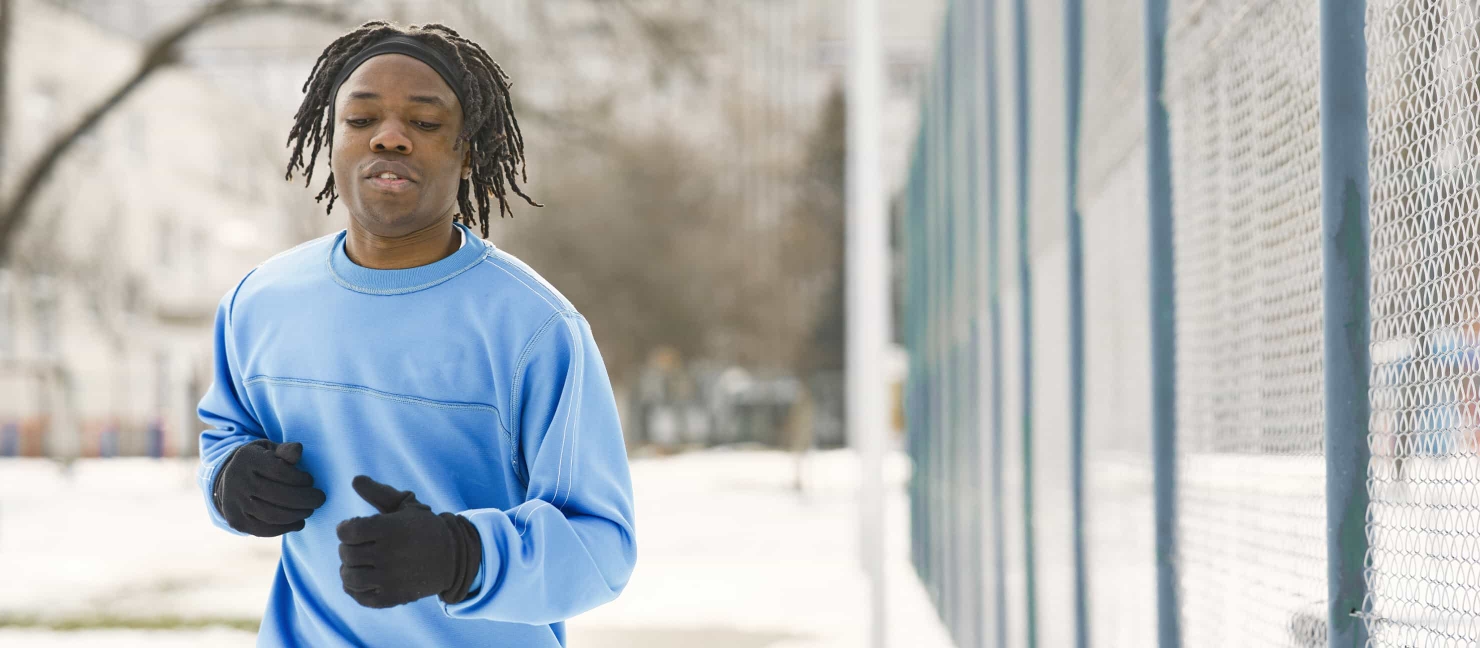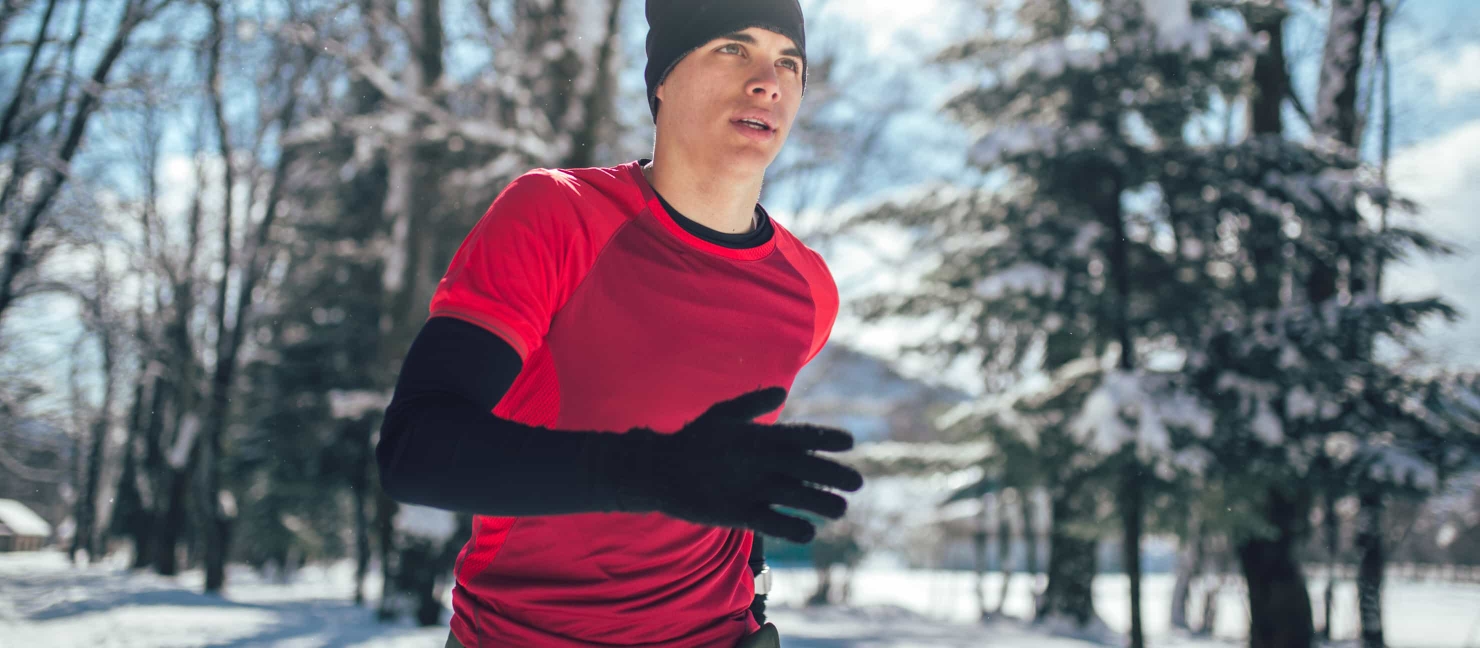Running in Winter: 10 Tips for Your Cold Weather Run

Is there anything like waking up than breathing in that sharp, crisp winter air on your morning run? Whether it's a light layer of snow that blankets the grass you pass, a full-blown storm, or a mix of icy slush covering your path ahead, running in winter can really shake up your routine!
Before you head out, keep reading to discover our top tips for running in the winter.
Key Takeaways
- Discover our top tips for running in the winter when it comes to preparing, motivating yourself, running safely, and more.
- Learn how to get started running in winter so you can find the motivation you need to get moving!
- Uncover how to run in cold weather and what steps to take before, during, and after your run.
- Learn what to wear on your winter runs so you can face the cold head-on.
- Find out our top winter running essentials like sunglasses and reflective gear so you can be as prepared as possible for your winter run!
How to Start Running in Winter
To get started running in winter, you just need to plan. An intentional route, the right layers bundling you while you set a comfortable pace, and the right pair of running shoes are really all it takes! Ultimately, the familiar bite of the outside cold air doesn’t have to keep you from running in winter.
“The first few minutes running are the toughest. But if you dress appropriately, running in the cold can be fun and productive! ”
Use These 10 Beginner Cold Weather Running Tips
Winter running is all about finding the inner strength to get out of bed and face the cold head-on. From the cold air brushing across your face to hearing the soft crunch of snow beneath your feet — it really can be an unforgettable experience!
1: Check the Forecast Before Your Run
Knowing the forecast can help you to plan when you can run and how long you can run. If you’re a beginner, it’s best to avoid running in below-freezing temperatures. Aim for sunny days between 30-45 degrees.
2: Dress Warm & Stay Warm
Wear insulated layers and breathable clothing (including a weatherproof jacket). Monitor your body temperature to prevent hypothermia or overheating. You know your body best, so if it’s too cold outside to run for you, run on an inside track or in the gym instead.

3: Tell Someone Your Running Route or Plans
Tell someone where you will be running and when you plan on being back. These tips can apply no matter what season you’re running in but are especially prudent during the winter. This way, if something were to happen to you, you have a backup plan in place and someone checking up on your safety.
4: Don’t Run If You’re Sick
Running while sick can lead to further infections and prolonged fevers and colds. Over-exerting yourself can be dangerous, especially when your symptoms are below the neck (think stomach bugs or nasty coughs). Your body needs time to heal, so get back to bed and get plenty of rest!
5: Breathe Through Your Nose Instead of Your Mouth
Breathing through your nose in the winter will warm up the air and block dust, making it easier to breathe.
Expert Tip:
If the cold irritates your lungs and you have trouble breathing through your nose, wear a scarf or neck gaiter that covers your mouth.
6: Wear Running Shoes with the Right Grip on the Bottom
It’s easy to slip and fall on icy and slushy spots in the winter. Ensure your running shoes have enough grip on the bottom so you don’t stumble and injure yourself.
7: Find Motivation
Lacing up your running shoes in the winter is never easy. Think about the peace and quiet that awaits you outside. You can also make a reward for yourself post-run (like a massage or sweet treat) and use that as motivation to get out the door.
8: Stay Hydrated
Simply being cold doesn’t mean you’re not thirsty. Bring a water bottle with you if you’ll be out on a long run and hydrate before, during, and after your run.
9: Don’t Overexert Yourself
Running in bitter weather typically isn’t the time you want to improve your pace. Instead, enjoy the journey, pay attention to your surroundings, and know your limits. Give yourself permission to end earlier and be flexible with yourself if your run doesn’t go according to plan.

10: Pick the Right Time of Day to Run
The sky is usually darker in the winter, which means you’ll want to be strategic about what time of day you plan on running. Mid-morning and mid-afternoon runs account for the most sunlight and are the perfect time to hit the road.
How to Run in Cold Weather: Step-by-Step Guidance
Unlike running in the summer, when you can throw on a pair of shorts and get out the door, running in the winter takes a bit of preparation and planning:
-
Step 1: Warm Up Before You Begin
-
Step 2: Start Running
Step 1: Warm Up Before You Begin
-
Get Your Body Warmed Up: Your muscles tend to be tighter in the winter due to the colder temperatures so be sure to warm up your body for 5-10 minutes with a brisk walk, jumping jacks, and dynamic stretches.
Step 2: Start Running
-
Go Slow and Steady: Avoid running on trails that are slick or have frozen over. Take it slow and steady and watch out for icy spots or puddles.
-
Don’t Push Yourself: Rather than running your usual distance, start off with a mile or two and then see how your body feels. If your run still feels manageable, then keep going, but don’t feel pressured to push yourself to the limits.
-
Choose Your Running Location Wisely: Try and run on a salted surface — whether that is a trail, road, or sidewalk.
Step 3: Add Recovery into Your Winter Run Routine
-
Stretch: When your body is warm, perform static stretches.
-
Focus on Recovery: You can use a foam roller to roll out your muscles, shower, and follow your typical post-run recovery routine.
-
Hydrate: Be sure to drink water, sports drinks with electrolytes, and other warm drinks to replace any of the fluids you lost while on your run.
Expert Tip:
Have a change of clothes on hand once you finish your run. Remove your damp clothes and change into your new ones right away so you can cool down and properly stretch.

What to Wear on Your Winter Run
-
Focus on Thin Layers: The key to bundling up for a winter run is wearing several thin layers. Base layers allow you to move your body and keep yourself warm without restricting movement.
-
Remember Your Body Heat Will Rise: Skip the snowsuit and opt for removable layers. You’ll want to find a balance between staying warm and not overheating. Run on a loop near your home or car where you can easily discard a layer.
-
Trap Body Heat: Warm hats, gloves, neck gaiters, and thick running socks can help protect your ears, face, toes, and other vulnerable body parts.
-
Wear the Right Shoes: Opt for running shoes with lots of traction to avoid slipping on icy patches. Buy winter traction devices to wear on your shoes if you need extra grip.
“Cover the hands, ears, and feet. Gloves, an ear warmer, and maybe thicker socks can help keep the extremities warmer. Your core, arms, and legs should warm up fairly quickly.”
Winter Running Essentials
-
Lights and Reflective Clothing: Wintery conditions mean low visibility for cars and snow plows out on the road. Make sure drivers can see you by wearing headlamps, reflective vests, and bright colors.
-
Stay Hydrated: Make sure you’re keeping your water intake up even in the cold weather. Drink plenty of fluids and you can even opt for warm beverages to stay hydrated.
-
Running Essentials: If you’re going on a longer run, wear a running belt or waist pack with running essentials like sunglasses, hand warmers, SPF, water, and more.

Expert Tip:
Put Vaseline on your exposed cheeks prior to a run. This will seal in moisture and protect against windburn.
Have Fun Out There!
While running in the cold or winter won’t be for everyone, there are several positive benefits it offers. According to the American Psychiatric Association, people who experience Seasonal Affective Disorder (SAD) endure it for 40% of the year when there is less sun outside.
When you want to support your fitness goals or just want some fresh air, try running in the winter. You can prepare for your next run by shopping for new running shoes.


